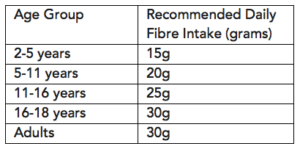
Fibre has evidence to show that its effects bring such things as: lowering cholesterol, blood pressure, reducing the risk of heart disease and strokes. It has also shown to aid gut health through feeding the good bacteria, of which in turn creates protective substances, and also research has shown that increasing your intake of this can reduce your risk of bowel cancer by 20% (based on a 90g/day increase).
Fibre also helps to keep you feeling fuller for longer, since fibre cannot be digested, it helps to push along food and waste products through the gut. This inability to digest fibre means that you are left feeling fuller for longer, and so you are less likely to feel the need to overeat.
Fibre can be found in many places, so if you’ve a varied and balanced diet, you’re on the right track and the variety of foods will be doing some good. However, even if you’re one of those people, it appears we’re all just not eating enough of it!
How much should I be eating?
Research has shown the average UK consumption is 18g per day. That is 60% of what it should be, 30g per day.
The advisory intake does vary for children, so check out the table below for the little ones.

If you’re looking to increase your fibre intake the best foods to introduce into your diet, or just eat more of, are foods such as porridge, breakfast cereals, sweet potato, beans and pulses, vegetables like peas, broccoli, fruits, seeds, and nuts.
Oats are a great source of fibre
According to the British Dietetic Association (BDA), one of the best tips for increasing your fibre intake is to have a high-fibre cereal such as oats at breakfast, as well as to add fruit to your cereal.
For example, half a cup of oats (contain around 9g fibre) with 80g raspberry’s (provides an extra 2-3g fibre). Therefore, a bowl of porridge or granola could be a great way to start your day with helping you immediately hit 1/3 of your daily requirement.

